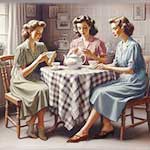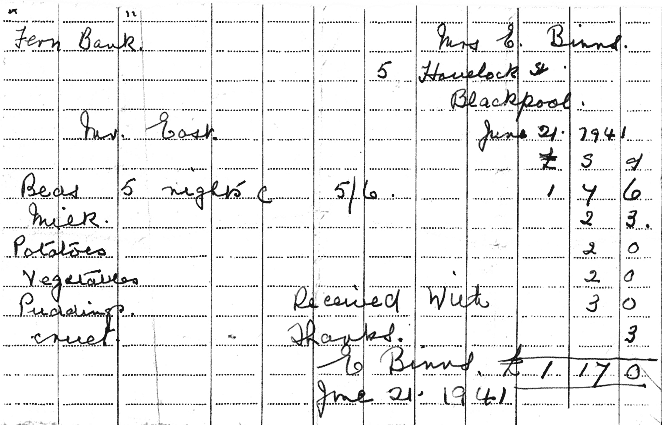
Off-ration meals outside the home during World War Two rationing

Meals eaten out in restaurants, pubs and teas shops in Britain were not rationed during the Second World War and its aftermath even though it was a time of severe rationing and shortages. The range and choiceof course was not what it was before the war and the venues had to impose their own form of rationing. This page elaborates.
____
By the webmaster based on her early recollections and discussions with older people
Food in all tea shops, work canteens and restaurants was not rationed, although, much of what customers would have liked to order was in short supply. So the tea shops, canteens and restaurants put in place their own rationing, allowing, for example, only one bun per customer.
Old films often seem to show wealthier people at the time eating luxury food in expensive restaurants. This was probably either dramatic licence or black market as by 1942 a maximum price of five shillings was fixed for a restaurant meal, (25p in today's money, a good example of inflation).
Fresh fish was not rationed from the fish and chips shops. It was cheap and plentiful. There was always a long line of people waiting for the fish and chip shop to open. The fish and chips were served in newspaper. So we could either eat them out of doors if the weather was fine or take them home to eat.
Peter Johnson
'Off-menu' foods
Many foods were simply off the menu. There are stories of other foods being substituted for them - often without the customers' knowledge. Horse meat was a well-known example.
School dinners were also off-ration, and the Government provided free school milk for children and set up British Restaurants for people living at home.
After the war there was even greater rationing, shortages and general austerity. My experience of school dinners comes from that time.
An 'eating out' receipt from 1941
The following receipt is for five nights holiday lodgings for a couple and their young son at Blackpool in 1941. It sheds a great deal of light the shortages, rationing and costs of living at the time while also being another example of inflation.

Receipt for lodgings and meals for two adults and one young child for five nights in Blackpool in 1941, indicating prices and food shortages of the time. Scan courtesy of Clifford East.
Overnight lodging, described as 'beds' cost 5/6 (five shillings and sixpence) a night.
The meals taken at the lodging do not appear to contain any protein such as meat, fish or eggs. Yet they must have been main meals because they seem to have consisted of potatoes and vegetables. These cost 4/- (four shillings) for the entire stay. Puddings cost 3/- (three shillings). Milk cost 2/3 (two shillings and three old pennies), but there is no indication of the quantity of the milk. There was nothing else at all consumed on the premises apart from salt and pepper, charged at 3d (three old pence), described as 'cruet'.
Clifford East, who donated the receipt and was the young son who consumed the milk, suggests that the protein would have come from eggs. He reports that his maternal grandfather was a registered poultry keeper during the Second World War, and that his family had eggs to take with them on holiday. These were given to the landlady to cook or to barter for some other form of protein.
Note that the receipt is not on headed notepaper. It probably came from a type of booklet that was common before computerisation and which consisted of duplicate sheets requiring a sheet of carbon paper to be inserted such that the seller kept a carbon copy still bound in the booklet and the buyer was given the torn-out top copy.
False pretensions at a B&B
The one time that my family ate-out was when my father was in the army and my mother took me to join him overnight at a B&B. I was just a toddler and the landlady 'generously' provided me with a glass of milk. I told my mother that it tasted horrible, although it looked fine. I wouldn't drink it and by the morning it had separated out into milk at the bottom of the glass with cloudy water on top.
Text and images are copyright
sources: early 20th century material
sources: ww2 home front and other material
contact
the webmaster/author/researcher/editor
privacy policy
















